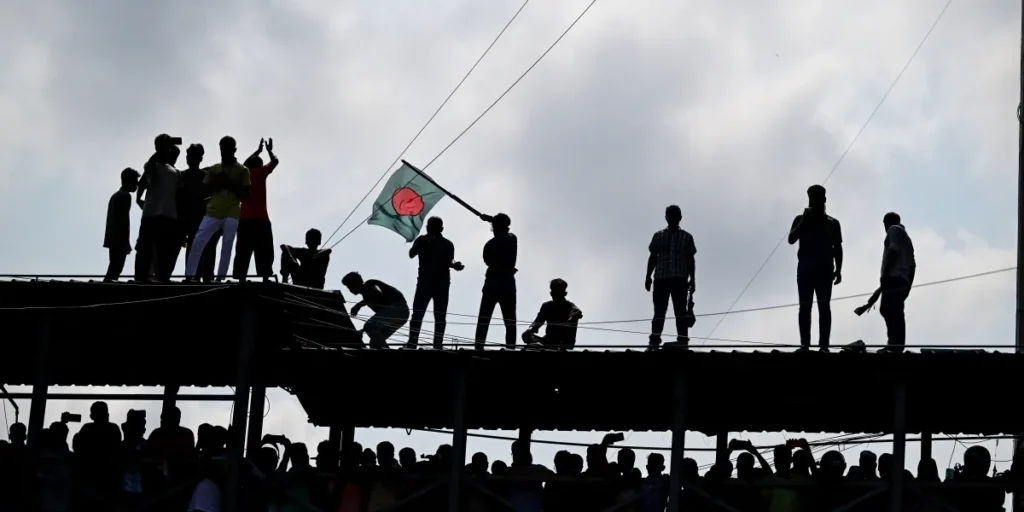
The 2024 student protests in Bangladesh were primarily driven by dissatisfaction with the reintroduction of a quota system for government jobs. This system, which allocated a significant percentage of jobs to descendants of veterans from the 1971 war of independence, was seen as discriminatory and limiting opportunities for merit-based candidates. This dissatisfaction culminated in widespread protests throughout the country, starting in June 2024.
Timeline of Events:
June 2024:
- The Supreme Court of Bangladesh reinstated a 30% quota for descendants of freedom fighters, overturning the government’s 2018 decision to abolish such quotas.
- Students began to protest this decision, calling for a fully merit-based recruitment system.
Early July 2024:
- Protests escalated as students from various universities across the country joined in. Demonstrations were largely peaceful initially, focusing on demands for job reforms and greater transparency in government recruitment.
Mid-July 2024:
- The protests turned violent when pro-government groups and security forces attacked demonstrators. The government responded with a heavy-handed approach, deploying police, the Rapid Action Battalion, and the military.
- Communications were disrupted, with a nationwide internet shutdown and blocking of social media platforms.
July 19, 2024:
- UN Human Rights Chief Volker Turk condemned the violent crackdown on student protests, which by then had resulted in dozens of deaths and hundreds of injuries. Reports emerged of paramilitary police units using lethal force against unarmed protesters.
- Dhaka saw significant clashes between students and police, with tear gas being used to disperse crowds and multiple fires reported across the city.
#Bangladeshstudentprotest has took a toll on the country. Destruction and death.
— BuzzWee (@The_buzzwee) August 5, 2024
know more at: https://t.co/LiTMvAxmqP pic.twitter.com/rKLXk0YZqN
July 21, 2024:
- The Supreme Court scaled back the quota system, reducing the reservation for war veterans’ descendants from 30% to 5%, and paving the way for 93% merit-based recruitment. Despite this, the protests continued as students were dissatisfied with the decision not to abolish the quota entirely.
- Internet and mobile services were restored after a 10-day blackout.
Late July 2024:
- Protests continued to spread, with significant incidents such as the storming of a jail in Narsingdi and the torching of the state broadcaster’s office. The death toll rose dramatically, with unofficial estimates suggesting between 300 and 500 fatalities.
August 4, 2024:
- Former Army Chief General Ikbal Karim Bhuiyan called for the withdrawal of troops and condemned the killings during the protests.
- Protests reached a peak with the announcement of a ‘Long March to Dhaka’, demanding the resignation of Prime Minister Sheikh Hasina.
August 5, 2024:
- Prime Minister Sheikh Hasina resigned and fled the country following the storming of her official residence by protestors. The Army confirmed her resignation and began working towards forming an interim government.
Bangladesh’s prime minister, Sheikh Hasina, resigned and left the nation on Monday afternoon amid mounting violence that has officially claimed over 400 lives; unsubstantiated estimates suggest that over 2000 people have perished. She was allegedly given 45 minutes to step down by the Bangladeshi army.
Though it hasn’t been verified, the former prime minister is reportedly on his way to Agartala, Tripura, according to the BBC’s India correspondent. She had already left the city with her sister, Sheikh Rehana, in a military helicopter when protesters earlier attacked her Dhaka home, according to ANI.
General Waker-Uz-Zaman, the head of the army, appealed for calm among the demonstrators and declared that the military will form a provisional administration. Violent skirmishes between students, police, and pro-government organizations occurred at Dhaka University as the turmoil, which started last month, grew more intense. Additionally, there were reports of demonstrators damaging a statue of Bangladesh’s founding father, Sheikh Mujibur Rahman.
Opposition to a contentious job reservation program that favored the families of veterans of the 1971 war served as the initial impetus for the protests, which have subsequently expanded into a larger anti-government movement. The demonstrators have persisted in their drive despite the government’s attempts to put an end to them through a statewide curfew and calls for talks, resulting in extensive bloodshed and destruction over 39 districts.
In an attempt to restore order, the government of Bangladesh is imposing an indefinite curfew starting at 6 p.m. on Sunday. The situation there is still tight. Many facets of society have expressed support for the protests, including celebrities who have used social media to spread the word about the campaign. The military has taken over as the nation’s temporary leader following Sheikh Hasina’s resignation, signaling a dramatic change in the political climate of the nation. Bangladesh is still in a state of upheaval as of early August 2024, with protests continuing and a sizable military presence. It is the interim government’s responsibility to bring the situation under control and fulfill the demonstrators’ requests. Human rights organizations and foreign observers are keeping a careful eye on events as the situation continues to be unstable. The protests have highlighted broader issues of governance, economic management, and human rights within the country.







